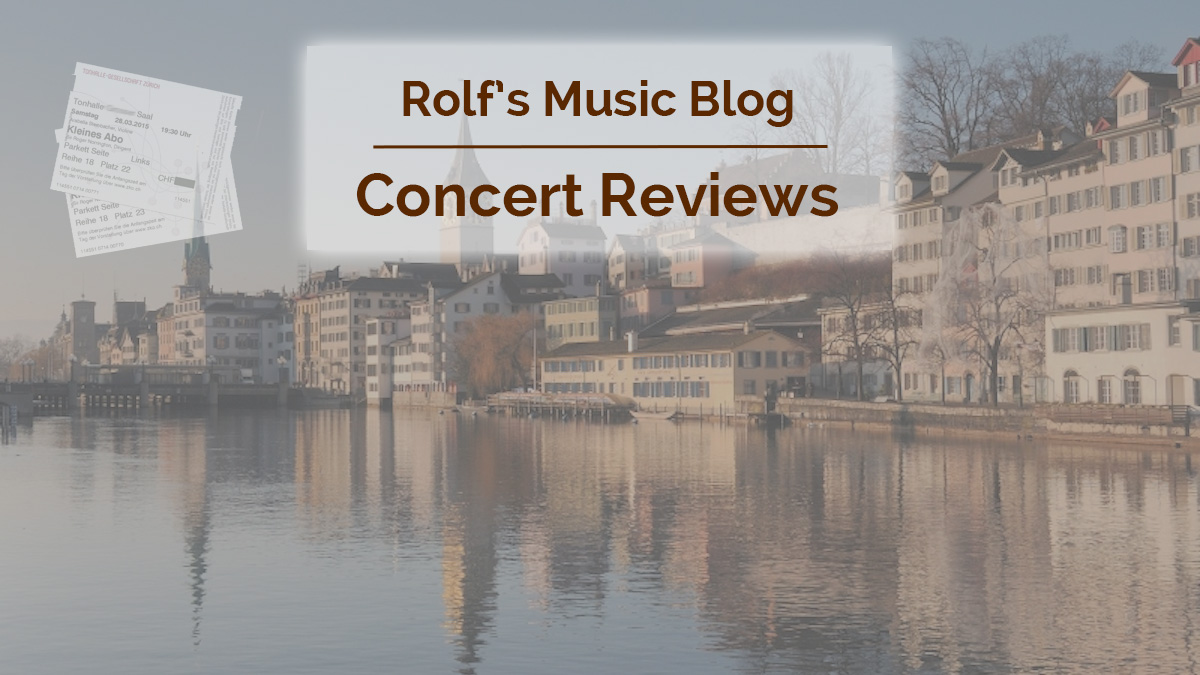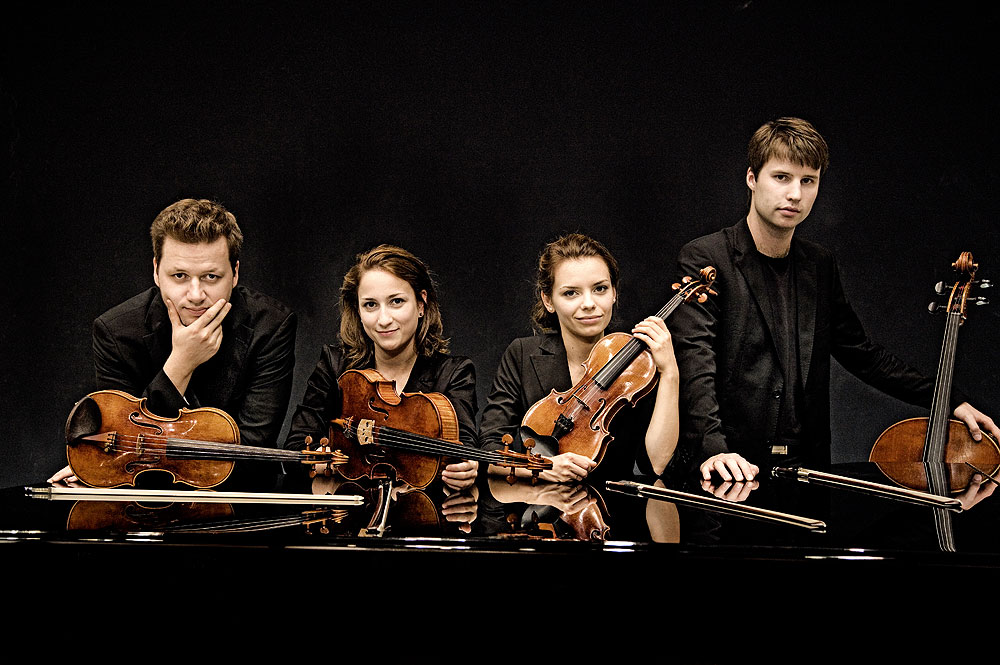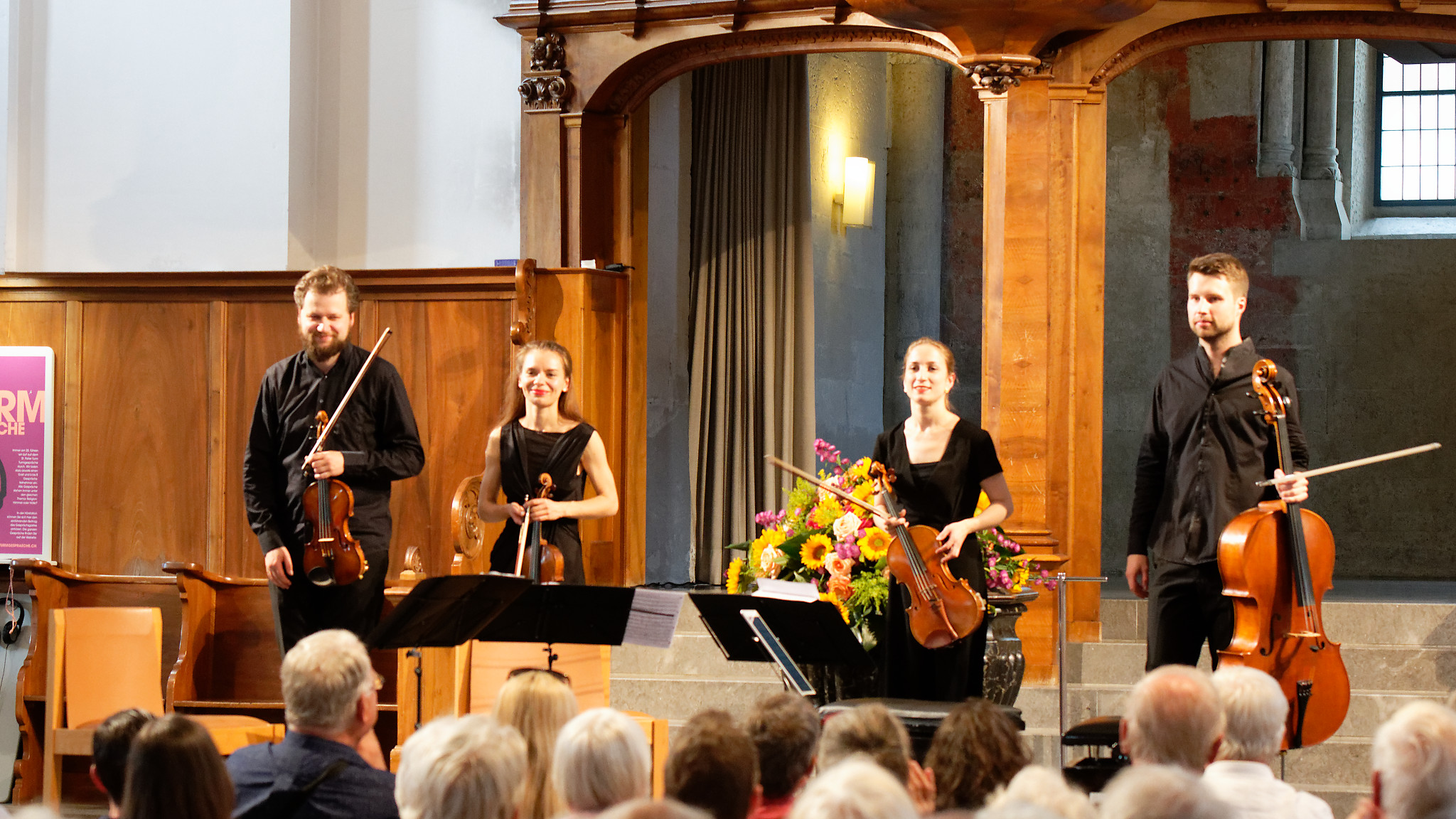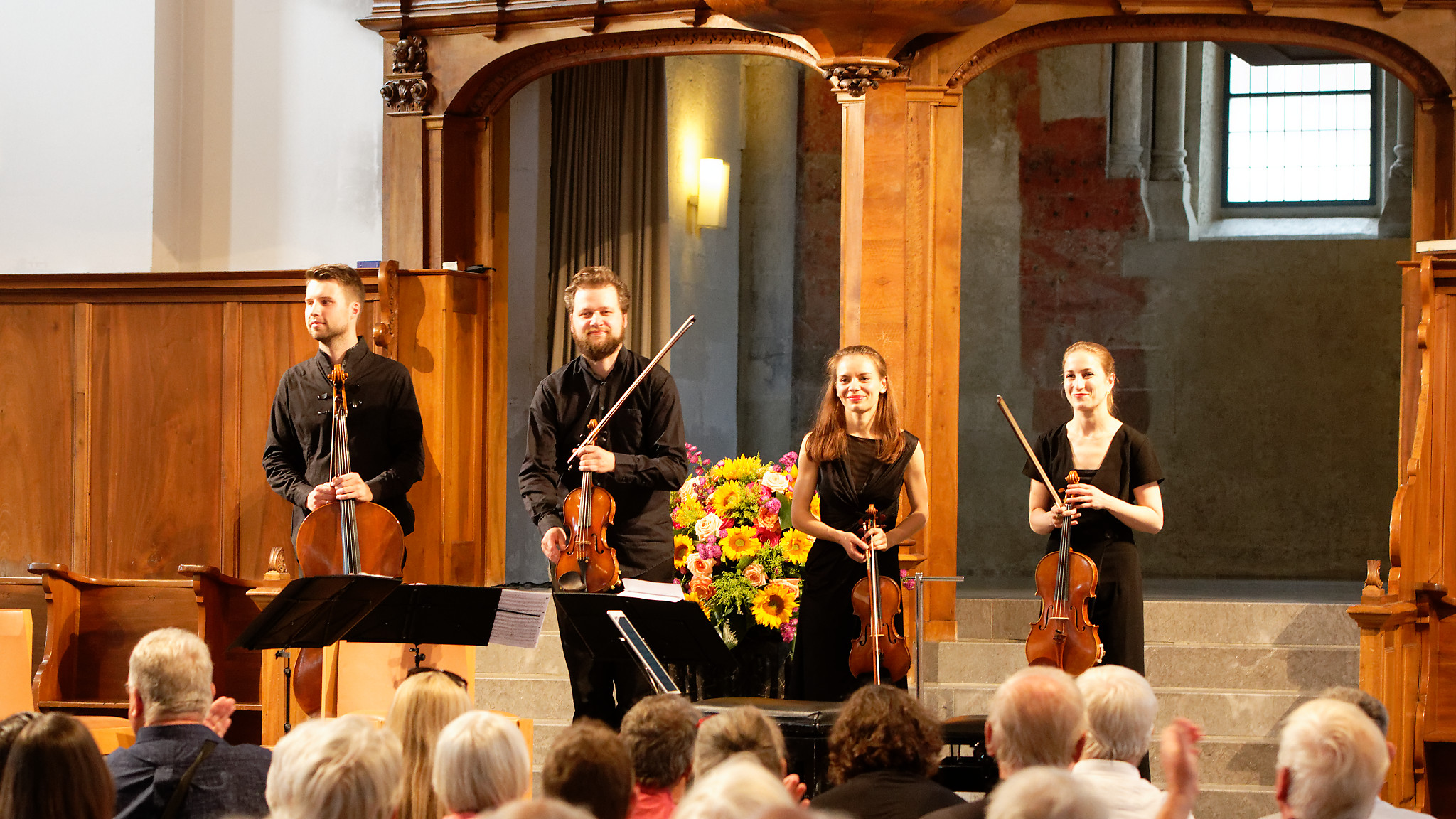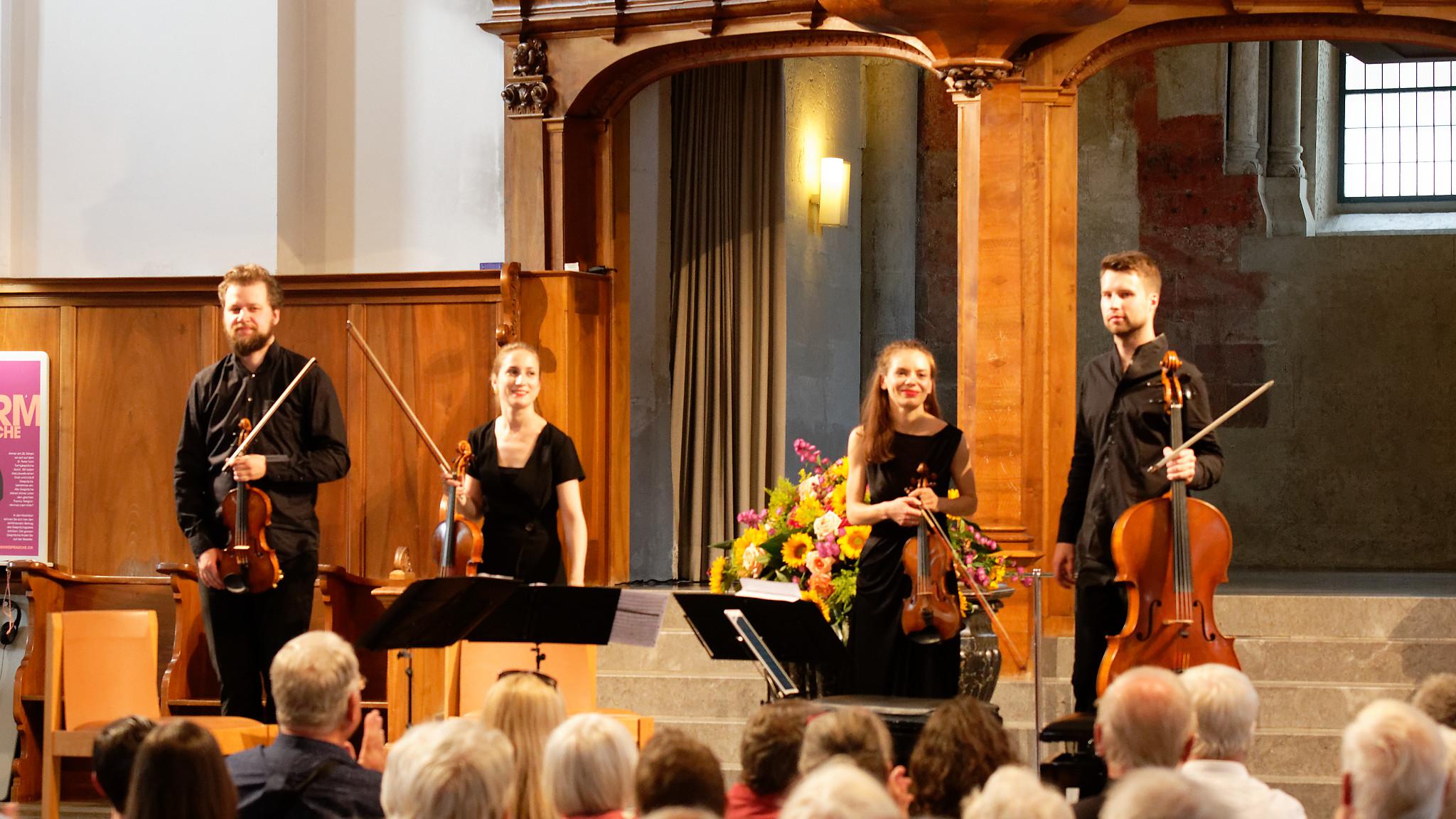Armida Quartet
Bach / Mozart / Beethoven
St.Peter, Zurich, 2018-07-08

2018-07-16 — Original posting
Harmonie, Anspruch und Realität: Das Armida-Quartett in Zürich — Zusammenfassung
In Mozarts Adagio und Fugue in c-moll, KV 546 und Auszügen aus Bachs “Kunst der Fuge” (Fugen I, IV, XI) präsentierte das Armida-Quartett harmonische, eigenständige Interpretationen. Bei Beethovens Streichquartett in B-dur, op.130 mit der “Großen Fuge” in B-dur, op.133, als Finalsatz war das Ensemble erwartungsgemäß deutlich mehr gefordert.
Table of Contents
Introduction
This concert with the Armida Quartet was the last one in the 2017/2018 series of string quartet recitals in Zurich’s St.Peter Church, organized by Hochuli Konzert AG.
The Artists
The Armida Quartet (see also Wikipedia) emerged 2006 in Berlin, with the four members that form the quartet up to this day, 12 years later:
- Martin Funda, violin (*1985 in Gera)
- Johanna Staemmler, violin (*1987 in Berlin, violin Goffredo Cappa, 1690)
- Teresa Schwamm, viola (*1988 in Augsburg)
- Peter-Philipp Staemmler, cello (*1986 in Mühlhausen / Thuringia)
The ensemble studied with members of the Artemis Quartet, thereafter they took master classes with quartets such as the Alban Berg Quartet, the Guarneri Quartet, and the Arditti Quartet. The quartet chose its name after “Armida”, the last opera that Franz Joseph Haydn (1732 – 1809) wrote in 1784.
The ensemble attended several competitions—and won first prizes (2011, Concours de Genève, and 2012, ARD Musikwettbewerb). With this, the quartet launched a successful concert career, so far primarily in German-speaking countries.The ensemble’s reputation obviously reached far enough to make this concert a success: for this warm, sunny Sunday afternoon, the church was filled surprisingly well (better than most preceding quartet recitals in this season).
Program
In its short career so far, the Armida Quartet has already recorded half a dozen CDs. And with the project of recording all of Mozart’s string quartets till 2021, they have set themselves an ambitious goal. Their most recent recording bears the title “Fuga magna” and features pieces by V. Haussmann, A. Scarlatti, J.S. Bach, J.G. Goldberg, W.A. Mozart, and L. van Beethoven—most of them fugues, as the title indicates. In this concert, the program featured three fugues (I, IV, XI) from Bach’s “Die Kunst der Fuge“ (The Art of the Fugue), Mozart’s Adagio and Fugue, K.546, as well as Beethoven’s String Quartet in B♭ major, op.130, with the “Große Fuge” (Great Fugue), op.133, as final movement.
The Bach fugues, Mozart’s K.546, as well as the Great Fugue op.133 by Beethoven are all part of their latest recording. It’s quite common for artists to perform excerpts from a recent CD release in concert—particularly in solo and chamber music recitals. However, to see this done with six out of eleven movements is rather unusual, but of course does not affect the concert experience.
This can’t possibly have been to promote the sale of their latest CD: these days, artists don’t earn much (if any) money from CD sales (the one exception are the scarce CD sales after a concert). I rather suspect that they resorted to repertoire pieces in order to leave enough rehearsal time for their very tight concert schedule during the upcoming festival season in the second half of July, and the first half of August.
Concert & Review
Bach: “Die Kunst der Fuge” (The Art of the Fugue), BWV 1080
In the last years of his life, Johann Sebastian Bach (1685 – 1750) composed a series of contrapuntal works (fugues, canons) on a common theme, organized in growing complexity (whereby the extra complexity involves adding additional themes, to form double and triple fugues, etc.). Bach did not complete this collection of pieces. The (presumably) last fugue remained incomplete.
The Armida Quartet selected 3 of the fugues to start their concert, all of which Bach labeled as Contrapunctus:
- simple, four-part fugue about the principal theme in its basic form
- simple, four-part fugue about the principal theme in its inverted form
- “a 4”: four-part triple (quadruple) fugue, about two (three) new themes and a variation of the principal theme.
Within a year, after the Hagen Quartett (2017-10-01) and the Chiaroscuro Quartet (2018-05-27), this is the third instance where I witness a string quartet starting a concert with fugues from Bach’s “Die Kunst der Fuge”. The Hagen Quartett selected fugues I through IV, the Chiaroscuro Quartet played the fugues I, III, and IX. Here, we heard the Fugues I, IV, and XI.
The Performance
Contrapunctus I
It’s the second violin which presents the principal theme in the first Contrapunctus. Somehow, this seemed indicative of Johanna Staemmler‘s lead role within the quartet. Here, and also later, it was she who seemed to signal beginnings / entries, through mimics and body language. She seemed to keep an eye on everybody, keeping constant visual contact with the others. Her husband, cellist Peter-Philipp Staemmler, on the right, was facing the first violin, Martin Funda. Both gave the impression of being more introverted than the two women in the center. The violist Teresa Schwamm was facing the audience, but did not play herself into the foreground.
In retrospect, the few bars of the exposition of the fugue already carried most the characteristics of the ensemble’s playing, almost throughout the concert. The artists used little or no vibrato (none at all in Bach’s fugues). The articulation was mellow, careful. Every tone seemed to form its own, rounded entity, yet was tied to its neighboring tones to form melodies, phrases / arches, even though not played entirely legato.
The theme alone demonstrated expressive dynamics , with clear crescendo and decrescendo around the theme’s climax. With the addition of the other voices, the quartet formed what seemed like a dense, web of voices, perfectly shaped in its own way. Yes, it was absolute music (as most of Bach’s fugues), but with focus on harmonious overall development. This differs from (maybe most?) other ensembles, which pointedly emphasize the fugue as analytical, abstract musical construct.
Contrapunctus IV
This did not differ too much from the first fugue, except for some extra emphasis, the gentle, light accents, slightly clearer articulation,and more détaché playing than in the first fugue. Also here, the overall flow and dynamics seemed to have higher priority than ultimate, analytic clarity.
Contrapunctus XI
Compared to the two fugues above, Bach’s Contrapunctus XI is vastly more complex, as triple or quadruple fugue with three or four themes. Themes in this polyphonic piece may be seen as autonomous or as linked, hence the divergence. The multitude in themes allows for additional differentiation and variation in articulation. One should keep in mind, though, that with the exception of ties (e.g., across bar lines), Bach did not specify any articulation whatsoever, nor any dynamics.
Even within the first theme, the articulation was very differentiated, maybe even a little extravagant in the Armida Quartet’s interpretation. The other themes contrasted to the first one, through more flowing, harmonious, more mellow articulation.
Overall, the performance in these three fugues seemed well-rounded, self-contained, with harmonious contours. Even without vibrato, the ensemble’s concept seemed relatively romantic, considering articulation and dynamics. This is in line with the use of modern or modernized instruments and Tourte bows. Throughout the fugues, I noted the artists’ very firm intonation, their excellent balance, and how well the instrument were matching each other in their sound characteristics. The latter is of course also the result of well-tuned articulation & technique, and balanced dynamics.
Rating: ★★★½
Mozart: Adagio and Fugue in C minor, K.546
In 1783, Wolfgang Amadeus Mozart (1756 – 1791) wrote a fugue for two pianos—his Fugue in C minor, K.426. Five years later, 1788, Mozart reworked this for string quartet and complemented it with a “short Adagio”. This is now known as Adagio and Fugue in C minor, K.546 for string quartet. Four years ago, I have posted a brief comparison of two recordings of K.546. I’ll therefore refrain from adding further comments on the composition.
The Performance
I. Adagio
As with the Bach fugues, I was pleased to note the playing with (virtually) no vibrato. I really hope that this is not just a momentary fashion!! The ensemble’s intonation was impeccable.
Tempo-wise, the Adagio felt unusually fluent (a little too fluent for an Adagio, maybe?). At the same time, apart from the punctuated theme head, the articulation was rather mellow. The artists avoided reinforcing the harmonic and rhythmic brusqueness in the theme, its unwieldy character with harsh, abrupt articulation (the absence of vibrato alone does enough of this already). In other words: with the exception of the theme head and the absence of vibrato, I had the impression of a rather romantic approach with softened contrasts.
II. Fugue
The fugue followed a similar philosophy: the staccato notes in the theme were short and properly accentuated, the tempo rather fluent. At the very least, I would say that they did not try exposing the slurred semiquavers in the theme. Rather, these were articulated somewhat summarily. Apart from the theme head, the artists seemed to focus on the slurs / the legato, and on the harmonious flow. Together with the reverberation in the church, this affected the transparency. The use of Tourte bows (and the relatively fast pace) probably did not help making the articulation lighter / more transparent. Finally: I didn’t quite understand why the quartet accelerated towards the end, especially as the pace was very fluent already.
Rating: ★★★
Beethoven: String Quartet in B♭ major, op.130 / Great Fugue in B♭ major, op.133
Ludwig van Beethoven (1770 – 1827) initially wrote his String Quartet in B♭ major, op.130 with a large fugue as last movement. That fugue met strong objection and was not understood by contemporary audiences. So, Beethoven ultimately decided to write a new Finale, and the fugue was published as Große Fuge (Great Fugue) in B♭ major, op.133. Basically, I think that one should perform the quartet op.130 in its published form, as this was the composer’s final decision.
Of course, in concert, artists are free to “reconstruct the original form”, by re-incorporating op.133 into op.130—ideally with the new finale as encore, maybe? This extra movement is often underestimated. One can also / easily perform the fugue as stand-alone piece, even though there is some anticipation of motifs / themes from the fugue in the earlier movements. Whatever—the Armida Quartet decided to re-incorporate the fugue into op.130, which then ended up with the following six (!) movements:
- Adagio, ma non troppo (3/4) — Allegro (4/4)
- Presto (alla breve, 2/2) — L’istesso tempo (6/4)
- Andante con moto, ma non troppo; poco scherzoso (4/4)
- Alla danza tedesca: Allegro assai (3/8)
- Cavatina: Adagio molto espressivo (3/4)
- Finale: Great Fugue, op.133
I have posted extensive comparisons of numerous (over a dozen) recordings of op.130 and of op.133. For details and more information on the composition see my comparison post for the String Quartet in B♭ major, op.130. There is a separate posting with a similar comparison for the Great Fugue in B♭ major, op.133.
The Performance
I. Adagio, ma non troppo — Allegro
Here now, the quartet allowed for a moderate, inconspicuous, and selective vibrato, this helped shaping long notes, particularly in the slow introduction. The articulation was again careful, mellow, the soundscape and the phrasing harmonious. The musicians carefully observed the details in Beethoven’s dynamic annotation. The exposition was repeated, as requested by the score.
It was interesting to observe the excellent sonority of the cello, which sounded so much like the viola in high positions that sometimes only a visual check revealed which instrument was playing. The articulation was not excessively broad (as in some traditional performances). Yet, with the acoustics in this venue, some of the semiquaver passages were not as clear as they could have been. With a slightly shorter articulation, this could have been avoided.
A nice, excellent detail: the (almost) whispered pp at the beginning of the development part. Also: the excellent sound balance—the first violin never made attempts to dominate inappropriately, each instrument contributed its adequate share to the result. The only snag: the intonation did not reach the same purity as in the preceding composition. A clear indiction of how demanding Beethoven’s quartet is! — ★★★
II. Presto — L’istesso tempo
The performance in the Presto was very virtuosic, though I did not have the impression that the artists tried showing off. There is no doubt that the musicians have the necessary technical means (agility, coordination , rhythmic firmness). The initial Presto was maybe a little too smooth, and in the subsequent parts, there were again some intonation issues, particularly in the first violin. Also, in the given acoustics, the tempo was at a point where the clarity started to suffer. — ★★★
III. Andante con moto, ma non troppo; poco scherzoso
Also here, I found the pace to be rather fluent—with the consequence of a slight (unmotivated?) drop in the tempo in the middle and towards the last segment with the demisemiquavers. The movement sounds technically easy—but if definitely isn’t: shaping the musical flow, keeping the tension, the overall pace are very, very hard. In Beethoven’s oeuvre, it’s often the slow(er) movements which are the most problematic for the artist. Also here, occasional intonation issues indicated the difficulties with this piece. — ★★★
IV. Alla danza tedesca: Allegro assai
The above remarks also apply to the Danza tedesca (“German dance”): a seemingly simple, but really tricky piece. Again, there were occasional intonation issues. On the other hand, I liked the swaying rhythm / agogics. I noted the detailed, careful dynamics and articulation, the mellow, flowing approach. This made Beethoven’s explicit swellings (e.g., in the middle of bars 1, 4, 9, 11) appear almost exaggerated. — ★★★
V. Cavatina: Adagio molto espressivo
No excess emotionality in the famous Cavatina, but excellent sonority in the sotto voce at the beginning of the movement. I also noted how carefully and almost meticulously the articulation was copied from one voice to the next in imitation sequences.
In the second half, there is a segment with a recitative-like passage in the first violin, seemingly independent of the accompaniment in triplets. If that sounded rhythmically slightly unclear, this probably was exactly what the composer intended. To me, this was the best movement in the Beethoven performance—even though I could easily picture slightly slower and even more subtle, gentle approaches. — ★★★
VI. Finale: Great Fugue, op.133
One should assume that the ensemble is familiar with the Great Fugue: it is also part of their latest recording. In my opinion, both the fast fugue segments were too fast: articulation and coordination were OK, but the transparency was suffering (especially with the amount of reverberation in this church), and (more so) the intonation was anything but flawless. It’s one of the most challenging movements in the entire quartet literature. Trying to push the tempo may seem to keep the length in check, but it also increases the challenge and doesn’t really make this easier to the listener. — ★★½
Overall Rating: ★★★
Conclusion
I was not surprised to note that Beethoven’s op.130 / op.133 presented the biggest challenges for the ensemble. Especially op.133 is probably also a challenge for the less experienced listener. Why otherwise were so many people rushing towards the exit so soon after the last chord? Very strange / odd, a real pity, and not very friendly to the artists! Even if one may not agree with all of their performance, and even if the late Beethoven was hard to understand: the quartet presented a remarkable performance, their technical abilities are at a very high level and deserved a decent applause!
Finally, a déjà vu: if I’m not completely mistaken, as already in a string quartet performance earlier this year, I noted Erich Höbarth sitting in the second row of the audience . He is the first violinist in the Quatuor Mosaïques, one of my all-time favorite string quartets, and one of the leaders / pioneer ensembles in the area of historically informed performances.
Addendum
For this concert I have also written a (shorter) review in German for Bachtrack.com. This posting is not a translation of the Bachtrack review, the rights of which remain with Bachtrack.com. I created the German review using a subset of the notes taken during this concert. I wanted to enable my non-German speaking readers to read about my concert experience as well. Therefore, I have taken my original notes as a loose basis for this separate posting. I’m including additional material that is not present in the Bachtrack review.

